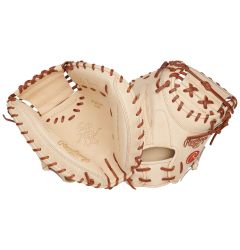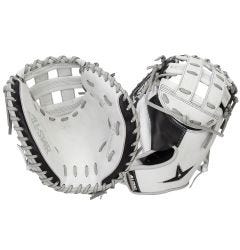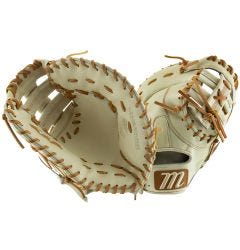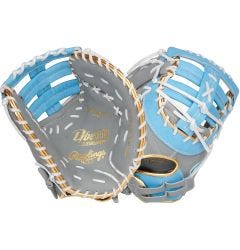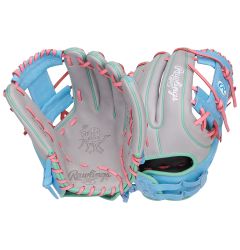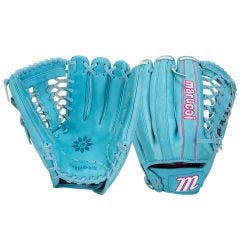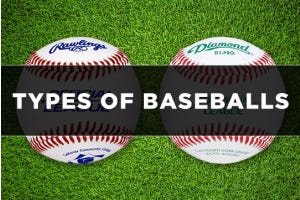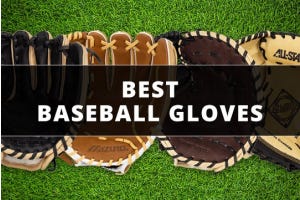Baseball & Fastpitch Glove Sizing Charts
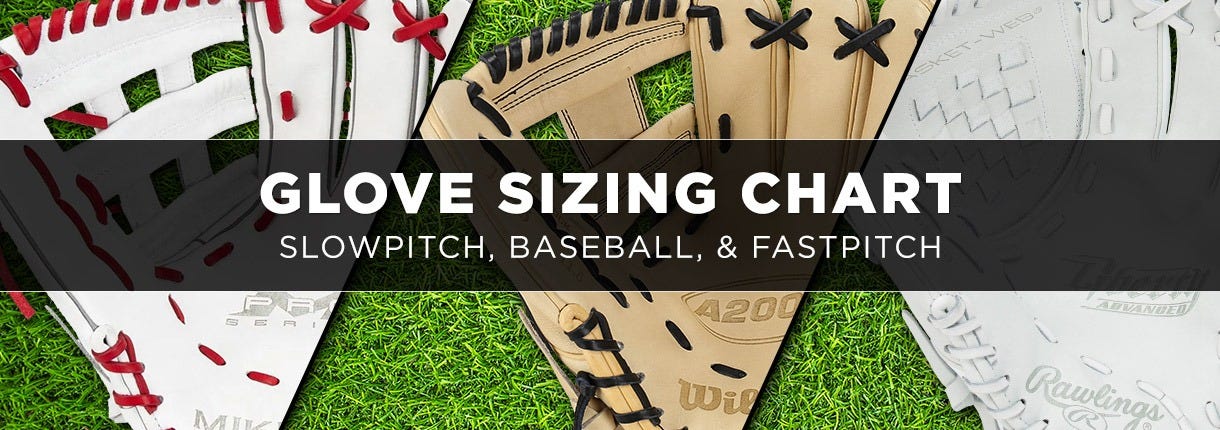
Looking for the perfect fit for your baseball glove or fastpitch glove? Our Baseball Glove and Fastpitch Glove Sizing Chart is here to help! Finding the right glove size is essential for optimal performance and comfort on the field. Our comprehensive chart takes into account various factors such as age, position, and hand measurements to guide you in selecting the ideal glove size. Don't settle for a glove that's too loose or too tight. With our sizing chart, you can make an informed decision and ensure a glove that fits like a glove should. Take your game to the next level with our Baseball Glove and Fastpitch Glove Sizing Chart today!
Baseball Glove Sizing Chart
| Age | Pitcher | Catcher | First Baseman | Second Baseman | Shortstop | Third Baseman | Outfielder |
|---|---|---|---|---|---|---|---|
| 7 and under | 8" - 10.5" | 29.5" - 30" | 8" - 10.5" | 8" - 10.5" | 8" - 10.5" | 8" - 10.5" | 9" - 10.5" |
| 8-10 | 10.5" - 11.5" | 30" - 31" | 11.5" - 12" | 10.5" - 11.25" | 10.5" - 11.25" | 10.5" - 11.5" | 10" - 12" |
| 11-13 | 11.5" - 12" | 30" - 32.5" | 11.5" - 12" | 11" - 11.5" | 11" - 11.5" | 11" - 11.75" | 11.75" - 12.75" |
| 14 & up | 11.5" - 12" | 32" - 34.5" | 12" - 13" | 11.25" - 11.5" | 11.25" - 11.5" | 11.5" - 12" | 12" - 13" |
Fastpitch Glove Sizing Chart
| Age | Pitcher | Catcher | First Baseman | Second Baseman | Shortstop | Third Baseman | Outfielder |
|---|---|---|---|---|---|---|---|
| 7 and under | 8" - 10.5" | 29.5" - 30" | 8" - 10.5" | 8" - 10.5" | 8" - 10.5" | 8" - 10.5" | 9" - 11" |
| 8-10 | 10.5" - 11.5" | 30" - 32" | 11.5" - 12" | 10.5" - 11.25" | 10.5" - 11.25" | 10.5" - 11.5" | 10" - 12" |
| 11-13 | 11.5" - 12.5" | 31" - 32.5" | 12" - 13" | 11.25" - 12" | 11.25" - 12" | 11.75" - 12.5" | 11.75" - 12.5" |
| 14 & up | 11.5" - 12.5" | 33" - 35" | 12" - 13" | 11.5" - 12.5" | 11.5" - 12.5" | 11.75" - 12.5" | 12" - 13" |
Slowpitch Glove Sizing Chart
| Pitcher | First Baseman | Second Baseman | Shortstop | Third Baseman | Outfielder |
|---|---|---|---|---|---|
| 11.5" - 13" | 12" - 13" | 11.5" - 12.5" | 11.5" - 12.5" | 11.75" - 13" | 12" -15" |
Types of Gloves By Position
Depending on the position you play, there are specific glove designs. From the web to the fingers, having the right glove for your position can make all the difference. Here is a breakdown of each positional glove and why they are important.
Catcher’s Mitts
The catcher’s mitt is the most specialized glove on the field. It is designed specifically to handle the demands of the position and the punishment of catching high-velocity pitches all day. Catcher’s mitts come in different styles and are made by many brands, so it's important to find the one that is best for you. The right mitt can elevate your performance on the field.
- Pocket Depth:
- Softball Mitts: Deeper pocket to accommodate the larger softball.
- Baseball Mitts: Shallower pocket suitable for the smaller baseball.
- Side Walls:
- Softball Mitts: Thinner side walls to handle the bigger ball.
- Baseball Mitts: Typically thicker side walls.
- Measurement:
- Softball Mitts: Measured around the circumference of the mitt.
- Baseball Mitts: Also measured around the circumference but usually smaller.
- Size Range:
- Baseball Mitts: Generally from 29.5 to 34.5 inches.
- Softball Mitts: Generally from 29.5 to 35 inches.
Baseball Catcher's Mitt
Softball Catcher's Mitt
Key Features
34” 1-Piece Solid Web
YM4 Pattern
Heart of the Hide Leather
Key Features
33” Pro H Web
Pull-Strap Back
Premium Grade Leather
First Base Mitts
First base baseball gloves, also known as first baseman's mitts, are specially designed to meet the specific needs of players at the first base position. First basemen often have to scoop low throws in the dirt from other infielders, so these gloves are designed with features to help keep the ball secure.
Edge Design:
First Baseman's Mitt: Features a continuous rounded edge that helps scoop and control balls thrown in the dirt.
Conventional Infielder's Glove: Typically has a more angular or flat edge, suited for quick transfers and fielding ground balls.
Webbing:
First Baseman's Mitt: Has the deepest webbing, usually a single post or H-web, to better control and catch balls.
Conventional Infielder's Glove: Generally has shallower webbing, like a closed or basket web, designed for quick ball transfer and better visibility.
Padding:
First Baseman's Mitt: Extra padding to absorb the impact from hard-thrown balls and provide protection.
Conventional Infielder's Glove: Standard padding suited for a range of fielding plays, with less focus on impact absorption.
Size Range:
First Baseman's Mitt: Typically ranges from 11.5 to 13 inches for both baseball and softball.
Conventional Infielder's Glove: Generally smaller, ranging from 11 to 12.5 inches, depending on the player's position and preference.
Baseball First Base Mitt
Softball First Base Mitt
Key Features
13” I Web
Premium Japanese-tanned USA Kip leather
Cabretta sheepskin lining
Key Features
13” H Web
Made from high-quality, full-grain leather
Adjustable Pull Strap back for a custom fit and optimal comfort
Infield Gloves
Infield gloves refer to gloves used by second basemen, third basemen, and shortstops. First basemen are not included as they have a separate category of gloves.
Length:
Baseball: Typically ranges from 11 to 12 inches for quick ball handling and transfers.
Softball: Usually ranges from 11.5 to 12.5 inches to accommodate the larger ball.
Pocket:
Baseball: Smaller pocket to help find the ball quickly and enhance ball control.
Softball: Slightly larger pocket to handle the bigger ball, though options are more limited.
Web Styles:
Baseball: Includes i-web, dual post, single post, modified trapeze, and 2-piece closed webs for varying depths and ball control.
Softball: Fewer web options due to the larger ball, often opting for more open webs.
Position-Specific Differences:
Third Basemen: Often use longer gloves with closed webs for better ball control and protection.
Shortstops and Second Basemen: Prefer shorter gloves with open webs for quicker transfers and more visibility.
Baseball Infield Gloves
Softball Infield Gloves
Key Features
11.5” I Web
Heart of the Hide Leather
Unique Geoprint Detail
Key Features
12” I Web
Heart of the Hide Leather
Adjustable Pull Strap
Outfield Gloves
Infield gloves refer to gloves used by second basemen, third basemen, and shortstops. First basemen are not included as they have a separate category of gloves.
Length:
Baseball: Typically ranges from 11 to 12 inches for quick ball handling and transfers.
Softball: Usually ranges from 11.5 to 12.5 inches to accommodate the larger ball.
Pocket:
Baseball: Smaller pocket to help find the ball quickly and enhance ball control.
Softball: Slightly larger pocket to handle the bigger ball, though options are more limited.
Web Styles:
Baseball: Includes i-web, dual post, single post, modified trapeze, and 2-piece closed webs for varying depths and ball control.
Softball: Fewer web options due to the larger ball, often opting for more open webs.
Position-Specific Differences:
Third Basemen: Often use longer gloves with closed webs for better ball control and protection.
Shortstops and Second Basemen: Prefer shorter gloves with open webs for quicker transfers and more visibility.
Baseball Outfield Gloves
Softball Outfield Gloves
Key Features
12.75” H Web
Heart of the Hide Leather
Timberglaze Monkey Exclusive
Key Features
12.5” T Web
Premium Japanese Kip Leather
Dual Wide Glove Shape
Baseball Glove Size Guide FAQs
- Why is it important to choose the right glove size for baseball or softball?
- Choosing the right glove size ensures a comfortable fit and optimal performance, allowing players to handle the ball more effectively. An ill-fitting glove can hinder a player’s ability to catch and throw accurately.
- What’s the difference between baseball and softball glove sizes?
- Baseball gloves are generally smaller and range from 9 to 12.5 inches, while softball gloves are larger, typically ranging from 11 to 15 inches, to accommodate the larger ball. Softball gloves also often have deeper pockets to handle the bigger ball.
- How does glove size affect performance for different positions?
- A glove that is too large can slow down a player's reaction time and handling, while a glove that is too small may not provide adequate coverage. Specific positions benefit from different sizes and types of gloves to enhance performance; for instance, infielders use smaller gloves for quicker transfers, while outfielders use larger gloves for a wider catching area.
- How do I choose the right glove size for a youth player?
- Measure the player’s hand and refer to age-appropriate size charts to select a glove that fits comfortably. Ensure the glove allows for easy closing and adequate control for their playing level and position.
- What role does glove size play in making quicker plays or transfers?
- A well-sized glove allows for faster ball retrieval and smoother transfers between hands, improving a player’s ability to make quick plays. A glove that is too large may slow down transfers and hinder a player’s reaction time.




